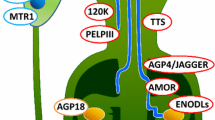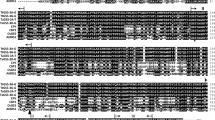Abstract.
The first evidence that higher plants contain annexins was presented in 1989. Since that time, annexins have been purified and characterized from a variety of plant sources. Analyses of the deduced proteins encoded by annexin cDNAs indicate that the majority of these plant annexins possess the characteristic four repeats of 70 to 75 amino acids and possess motifs proposed to be involved in Ca2+ binding. Like animal annexins, plant annexins bind Ca2+ and phospholipids and are abundant proteins, but there are indications that the number of distinct plant annexin genes may be considerably fewer than that found in animals. Regarding function, a number of studies show that various members of the annexin family of plants may play roles in secretion and/or fruit ripening, show interaction with the enzyme callose (1,3-β-glucan) synthase, possess intrinsic nucleotide phosphodiesterase activity, bind to F-actin, and/or have peroxidase activity.
Similar content being viewed by others
Author information
Authors and Affiliations
Rights and permissions
About this article
Cite this article
Delmer, D., Potikha, T. Structures and functions of annexins in plants. CMLS, Cell. mol. life sci. 53, 546–553 (1997). https://doi.org/10.1007/s000180050070
Issue Date:
DOI: https://doi.org/10.1007/s000180050070




